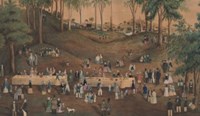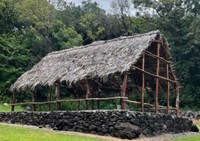- Lesson Plan (14)
- Student Activities (3)
- Field Trips (1)
- Traveling Trunk (1)
- Kings Mountain National Military Park (6)
- Cowpens National Battlefield (2)
- Haleakalā National Park (2)
- Ninety Six National Historic Site (2)
- Blackstone River Valley National Historical Park (1)
- Cane River Creole National Historical Park (1)
- Castillo de San Marcos National Monument (1)
- Great Sand Dunes National Park & Preserve (1)
- Independence National Historical Park (1)
- Show More ...
- Social Studies (17)
- Literacy and Language Arts (11)
- Science (7)
- Math (2)
- 9-10.RH.1 (4)
- 9-10.RH.2 (4)
- 9-10.RH.3 (4)
- 9-10.RH.4 (3)
- 9-10.RH.5 (3)
- 9-10.RH.7 (3)
- 9-10.RH.8 (3)
- 11-12.RH.1 (2)
- 11-12.RH.2 (2)
- Show More ...
Showing 19 results for Martin Luther King ...
“Now is the Time!”: Three Men, Three Speeches, and the Promise of Equality
- Type: Lesson Plan
- Grade Levels: High School: Ninth Grade through Twelfth Grade

This lesson plan gives students the opportunity to engage with the context of the national civil rights conversation as it progressed in the spring of 1963. Students will examine three speeches by Dr. Martin Luther King Jr., President John Fitzgerald Kennedy, and Vice President Lyndon Johnson. Students will engage in a conversation about the similarities and differences between these speeches and discuss their themes, then connect those themes to current conversations regarding civil rights.
Mars Traveling Trunk
- Type: Traveling Trunk
- Grade Levels: Upper Elementary: Third Grade through Fifth Grade
Journey through time and space, through the geography and geology of sand dunes, and the feats of engineering that make such exploration possible.
Civil Rights Leaders Bingo
Marching for the Movement in St. Augustine
The Liberty Bell as a Symbol for Civil Rights, grades 4-8
The Battle of Kings Mountain
- Type: Student Activities
- Grade Levels: Upper Elementary: Third Grade through Fifth Grade
The Battle of Kings Mountain (October 7, 1780) was one of the most dramatic and hotly contested battles of the Revolutionary War. On an isolated ridge top in the Carolina backcountry, nearly 1000 American Patriots surrounded and overwhelmed an approximately equal number of American Loyalists.
Tactics in the Battle of Kings Mountain
- Type: Lesson Plan
- Grade Levels: Middle School: Sixth Grade through Eighth Grade
*How did the Kings Mountain area terrain and settlements effect the tactics in the Battle of Kings Mountain? *How were the tactics used at the Battle of Kings Mountain similar and different than other battles in the American Revolution? *How were the tactics used by loyalists and patriots at the Battle of Kings Mountain similar and different?
He Aha Lā He Kūkulu?
ʻĀhinahina Haleakalā
Topography
- Type: Student Activities
- Grade Levels: Upper Elementary: Third Grade through Fifth Grade
The Battle of Kings Mountain is an excellent example of how landscape and geography can affect the outcome of events.
Loyalists in American Revolution
- Type: Student Activities
- Grade Levels: Upper Elementary: Third Grade through Fifth Grade
John Adams wrote that approximately one-third of the American population supported the move for independence (Patriots), one-third of the population supported the king (Loyalists), and one-third supported neither side (neutral).
- Type: Lesson Plan
- Grade Levels: Middle School: Sixth Grade through Eighth Grade
Students will work to calculate time, distance, gas mileage from home to three important Southern Campaign of the American Revolution: Cowpens National Battlefield, Kings Mountain National Military Park, and Ninety Six National Historic Site.
- Type: Lesson Plan
- Grade Levels: Middle School: Sixth Grade through Eighth Grade
Students will research information to find information about the number of wounded from both patriot and British forces from the SC revolutionary battles: Battle of Camden, Battle of Waxhaws, Kings Mountain, and Cowpens. They will then create a graph that compares the number both injured and fatally wounded.
"Temperature, Clouds and Sun is Weather - Oh, My!"
- Type: Lesson Plan
- Grade Levels: Lower Elementary: Pre-Kindergarten through Second Grade

The program consists of videos, hands-on projects, and observation-based activites. The participant will: Create a cloud headband. Learn about the job of a Meteorologist. Predict tomorrow’s weather. Learn about Martin Van Buren’s year without a Summer. Conduct an experiment to create a cloud in a jar and document the type of cloud by comparing it to a cloud chart. Enjoy some En Plein Air drawing or painting of cloud formations.
- Type: Lesson Plan
- Grade Levels: Lower Elementary: Pre-Kindergarten through Second Grade

The program consists of videos, hands-on projects, and observation-based activites. The participant will: Create a cloud headband. Learn about the job of a Meteorologist. Predict tomorrow’s weather. Learn about Martin Van Buren’s year without a Summer. Conduct an experiment to create a cloud in a jar and document the type of cloud by comparing it to a cloud chart. Enjoy some En Plein Air drawing or painting of cloud formations.
Peace Picnics and Community in Hopedale
- Type: Lesson Plan
- Grade Levels: High School: Ninth Grade through Twelfth Grade

In 1842, a group of like-minded individuals created a commune called Hopedale. Under the leadership of minister Adin Ballou, people came to Hopedale to live out their values, which included Christian non-resistance and abolition. In this lesson, students will read primary source accounts about anti-slavery meetings and celebrations independence in Hopedale, MA and consider how people use speeches and print to make persuasive arguments.
Layers in Time
- Type: Field Trips
- Grade Levels: Upper Elementary: Third Grade through Fifth Grade

Sequoia and Kings Canyon National Parks were once home to over 3,000 Monache American Indians. Visit the ancient home of the Monache at Hospital Rock; explore their rock art, their cooking areas, and more. Participate in a mock archaeological dig on a pre-trip classroom program! Uncover the rich cultural history of the Kaweah River region.







